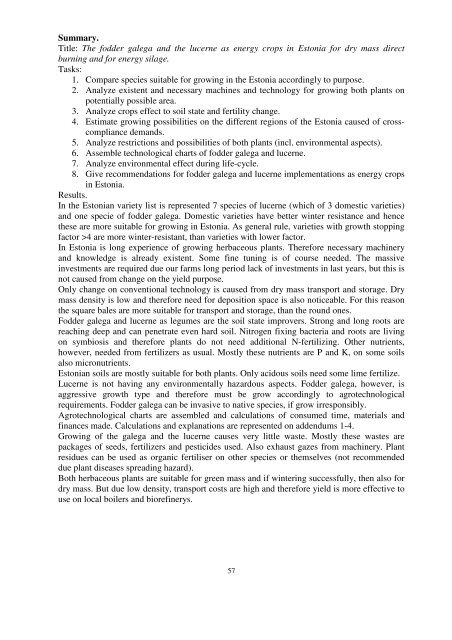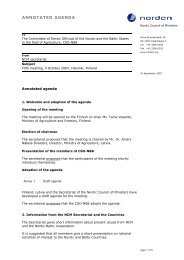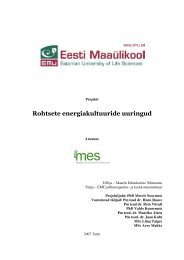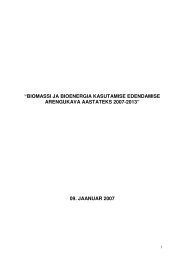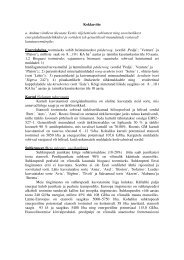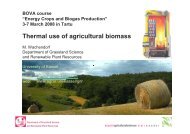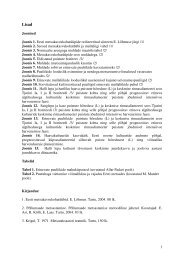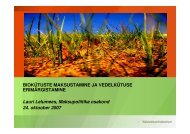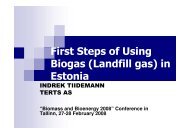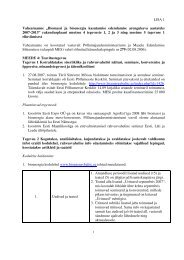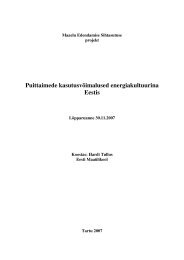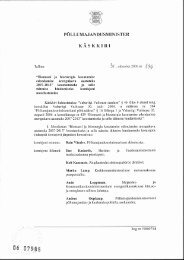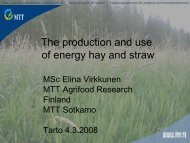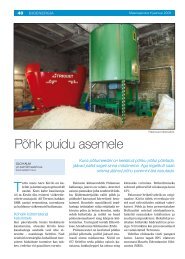Põllumajandusministeeriumi ja Maaelu ... - bioenergybaltic
Põllumajandusministeeriumi ja Maaelu ... - bioenergybaltic
Põllumajandusministeeriumi ja Maaelu ... - bioenergybaltic
Create successful ePaper yourself
Turn your PDF publications into a flip-book with our unique Google optimized e-Paper software.
Summary.<br />
Title: The fodder galega and the lucerne as energy crops in Estonia for dry mass direct<br />
burning and for energy silage.<br />
Tasks:<br />
1. Compare species suitable for growing in the Estonia accordingly to purpose.<br />
2. Analyze existent and necessary machines and technology for growing both plants on<br />
potentially possible area.<br />
3. Analyze crops effect to soil state and fertility change.<br />
4. Estimate growing possibilities on the different regions of the Estonia caused of crosscompliance<br />
demands.<br />
5. Analyze restrictions and possibilities of both plants (incl. environmental aspects).<br />
6. Assemble technological charts of fodder galega and lucerne.<br />
7. Analyze environmental effect during life-cycle.<br />
8. Give recommendations for fodder galega and lucerne implementations as energy crops<br />
in Estonia.<br />
Results.<br />
In the Estonian variety list is represented 7 species of lucerne (which of 3 domestic varieties)<br />
and one specie of fodder galega. Domestic varieties have better winter resistance and hence<br />
these are more suitable for growing in Estonia. As general rule, varieties with growth stopping<br />
factor >4 are more winter-resistant, than varieties with lower factor.<br />
In Estonia is long experience of growing herbaceous plants. Therefore necessary machinery<br />
and knowledge is already existent. Some fine tuning is of course needed. The massive<br />
investments are required due our farms long period lack of investments in last years, but this is<br />
not caused from change on the yield purpose.<br />
Only change on conventional technology is caused from dry mass transport and storage. Dry<br />
mass density is low and therefore need for deposition space is also noticeable. For this reason<br />
the square bales are more suitable for transport and storage, than the round ones.<br />
Fodder galega and lucerne as legumes are the soil state improvers. Strong and long roots are<br />
reaching deep and can penetrate even hard soil. Nitrogen fixing bacteria and roots are living<br />
on symbiosis and therefore plants do not need additional N-fertilizing. Other nutrients,<br />
however, needed from fertilizers as usual. Mostly these nutrients are P and K, on some soils<br />
also micronutrients.<br />
Estonian soils are mostly suitable for both plants. Only acidous soils need some lime fertilize.<br />
Lucerne is not having any environmentally hazardous aspects. Fodder galega, however, is<br />
aggressive growth type and therefore must be grow accordingly to agrotechnological<br />
requirements. Fodder galega can be invasive to native species, if grow irresponsibly.<br />
Agrotechnological charts are assembled and calculations of consumed time, materials and<br />
finances made. Calculations and explanations are represented on addendums 1-4.<br />
Growing of the galega and the lucerne causes very little waste. Mostly these wastes are<br />
packages of seeds, fertilizers and pesticides used. Also exhaust gazes from machinery. Plant<br />
residues can be used as organic fertiliser on other species or themselves (not recommended<br />
due plant diseases spreading hazard).<br />
Both herbaceous plants are suitable for green mass and if wintering successfully, then also for<br />
dry mass. But due low density, transport costs are high and therefore yield is more effective to<br />
use on local boilers and biorefinerys.<br />
57


